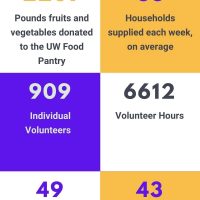April Plant Profile: Montezuma Pine
Here at the Washington Park Arboretum we are lucky to care for many extraordinary trees. One of these amazing trees is our single specimen of Montezuma pine, Pinus montezumae var. lindleyi (Accession number 506-65-A) planted at the northeast corner of Crabapple Meadow in 1969. I first became acquainted with this tree in the spring of 2017 when I was the Teaching Assistant for a Landscape Plant Recognition class at the University of Washington.
Read moreRare Care Plant Profile
An endemic plant found only in Benton County of Washington State, Umtanum desert buckwheat (Eriogonum codium) is a long-lived perennial adapted to grow in an arid landscape. This compact, tufted plant forms a low-branching woody stem from a stout taproot and spreads 2-9 dm laterally but rarely reaching a height much higher than 8 inches. Leaves are basal, oblanceolate to elliptic in shape, and only 6-12 mm long x 3-6 mm wide.
Read moreRare Care 2024 Volunteer Spotlight
Each Year Rare Care recognizes volunteers for their outstanding contributions
Jane Engle is a relatively new Rare Care volunteer, having completed the training in 2022; however, she has come out of the gate running. Jane contributed over 147 total hours in 2023. As a first year seed collector, Jane collected seeds for Veronica schizantha in Gifford-Pinchot National Forest with the help of her assistant and mapper Duane Engle.
2024 Rare Care Spring/Summer Team
Rare Care’s team has changed once again this year. We would like to welcome all of the new faces and recognize the returning staff who make our work possible.
In late 2023, Andrea Cummins was hired as the new Volunteer & Outreach Coordinator–most of you have probably already seen a flood of emails from her this year. Andrea is a past Rare Care volunteer (several years past) and is very pleased to once again be a part of a program that plays such an important role in plant conservation and lands managment across the state.
Testing Direct Seeding for an Arid Endemic
As home gardeners know, sowing seeds is much cheaper than buying plant plugs. In 2019, Rare Care started an experiment to test if direct seeding of White Bluffs bladderpod (Physaria douglasii ssp. tuplashensis) could be an efficient method to establish new populations.
Establishing a new population of White Bluffs bladderpod would help meet the Recovery objectives for this threatened species. It is a single-site endemic found only on a narrow, 17-km stretch of the White Bluffs on the east side of the Columbia River.
Planting for Recovery
Planting 672 plugs and sowing 45,000 seeds by hand takes no small effort. That was our goal this past fall when we planted Wenatchee Mountains checker-mallow (Sidalcea oregana var. calva) at three sites in Chelan County and Umtanum desert buckwheat (Eriogonum codium) at one site in Grant County. Fortunately, we had three days, nine volunteers, seven agency partners, one graduate student, one faculty, two undergrads and three staff to get it all done.
Read moreMarch 2024 Plant Profile: Japanese Ornamental Cherry Tree Acquisitions
Scientific name: Prunus species
Various species:
P. Sato-zakura Group: Cultivars: ‘Shirotae’, ‘Shoetsu’, ‘Ukon’ ‘Chosho-Hizakura’, Sekiyama’
‘Ohochin’ ‘Oeshokun’
P. serrulata: Cultivars: ‘Asagi’ ‘Iohiyo’, ‘Shirofugen’, ‘Tai-Haku’, ‘Taoyome’ ‘Wase-Miyako’ ‘Horinji’
P. subhirtella: Cultivars: ‘Eureka Weeping’ ‘Pendula’ ‘Rosea’ ‘Stellata’ ‘Higan Weeping’ ‘Whitcomb’
P. sargentii: Cultivar: ‘Pink Flair’
Prunus x yedoensis: Cultivar: ‘Akebono’, ‘Shidare-yoshino’, ‘Somei-Yoshino’
P. x juddii
Common name: Japanese Ornamental Cherry
Family: Rosaceae
Native Range: Japan
In the Arboretum: Along Azalea Way
Issues: brown rot, cherry bark tortrix larvae, crown gall, root rot, low tolerance of compacted or wet soils
During spring’s first blossoms, I brag to anyone who will listen that the Japanese ornamental cherries at the Washington Park Arboretum are the most amazing display in the city and that they MUST go for a walk along Azalea Way to view this splendor.
UW Farm Weekly Dirt: UW Farm Catalyzes Careers in Urban Farming

One of the best responses I’ve gotten after telling someone I’m a farmer is: “Are you okay?” And it is a fair question, though the answer changes based on what time of year it is. There’s the unbridled optimism of early spring, the growing suspense in April and May (what weather-related surprises will climate change bring us this year?), staring into the void in June, and then summer hits and the rest of the season is a downhill run.
Read moreFebruary Plant Profile: Wheel Tree

Scientific name: Trochodendron aralioides
Synonyms: Trochodendron longifolium
Common name: Wheel tree, parasol tree, birdlime tree, yamaguruma, nagaba-no-yamguruma, kun lan shu, ka-tang-lai
Family: Trochodendraceae
Native Range: Japan (south of Yamagata), Kyushu, Shikoku, Ryuku Islands, Taiwan
Height and Spread: May grow from 60-75 tall feet in the wild with trunks as large as 16 feet in diameter, typically 20-25 feet tall by 10-15 feet wide in cultivation.
UW Farm Weekly Dirt: 2023 Impact Directs Campus Farm’s Food Security Priorities for the Upcoming Growing Season

In 2023, the UW Farm experienced highs and lows, new accolades and challenges. We struggled with crop failures of melons, corn, and onions, while successfully cultivating quinoa and wheat for the very first time! Certified organic produce donated by the UW Farm in 2023 reached 2390.57 pounds, worth a retail value of $11,870.00. The largest volume of donated produce was delivered to the campus UW Food Pantry.
Read more